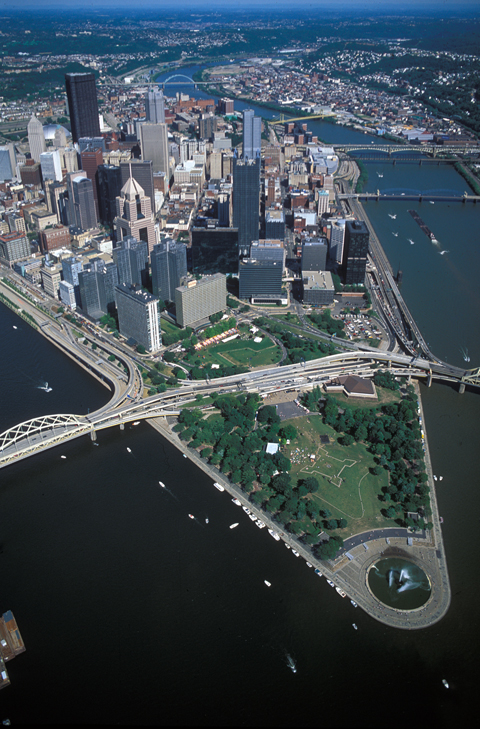The Monongahela River (right) joins the Allegheny River at the apex of Pittsburgh’s “golden triangle” to form the river called Ohio—an Iroquois word meaning “big and beautiful.” After the Revolutionary War, Pittsburgh quickly grew into a gathering-place and jumping-off point, “The Key to the Western Country.” Revolutionary War veterans, who had been paid with grants of free land on the frontier, surged down the big river to claim their stakes in the new and expanding frontier. In 1802, according to Zadok Cramer, author of the leading boatman’s guidebook to the Ohio, the town of 2,000 inhabitants consisted of about four hundred dwellings, “many of them large and elegantly built with brick.” Some local historians believe that the expedition’s military barge (called the ‘boat’ or ‘barge’ but never the ‘keelboat’) was built at William Greenough’s boatyard, which was near the north (left) end of today’s Liberty Bridge, the third one from the bottom, at right.
When Meriwether Lewis set out from there at 11:00 a.m. on 31 August 1803, the rivers were lower than anyone could remember. Experienced boatmen had advised him not to go, but Lewis had no choice. On many gravel bars, Lewis later wrote to Jefferson, the water in many places was a scant six inches deep, while his new custom-built fifty-five-foot barge needed two and a half feet, and often had to be dragged over the riffles by teams of horses or oxen hired from farmers. “The inhabitants who life near these riffles live much by the distressed situation of traveller charge extravagantly when they are called on for assistance and have no filantrophy or continence,” Lewis complained.
Just three miles down the Ohio from Pittsburgh, Lewis went ashore for a short visit with some friends from the Masonic Lodge[1]See also Lewis as Master Mason, and in moments came within a few one-hundredths of an inch of an accident that could have indelibly stained the history of the Lewis and Clark expedition. After demonstrating the powerful repeating pneumatic rifle[2]See The Air Gun and Air Gun Accident. he had borrowed in Philadelphia for the duration of the expedition, he let a bystander take a closer look at it. Being unfamiliar with this smokeless, practically noiseless “stealth weapon,” the man accidentally discharged it, firing a bullet into the crowd. The ball, possibly of forty-six caliber, passed through the hat of a woman standing forty yards away. She fell to the ground, blood gushing from her temple. “We were all in the greatest consernation,” Lewis recalled, fearing she was dead. But in a moment she revived, “to our enespressable satisfaction, and by examination we found the wound by no means mortal or even dangerous.”
Considering that each of the men in the Corps of Discovery carried at least one firearm, and that many guns were in use daily by the hunters, they came out with a remarkably good safety record. The only other gun mishap that drew blood occurred on 11 August 1806, just four weeks from the expedition’s end, when Pierre Cruzatte mistook the buckskin-clad Lewis for an elk, and shot him in the buttocks, inflicting a painful and temporarily incapacitating wound.
See also on this site Leaving Pittsburgh.
From Discovering Lewis & Clark from the Air
Photography by Jim Wark
Text by Joseph Mussulman
Reproduced by permission of Mountain Press
Notes
| ↑1 | See also Lewis as Master Mason |
|---|---|
| ↑2 | See The Air Gun and Air Gun Accident. |

